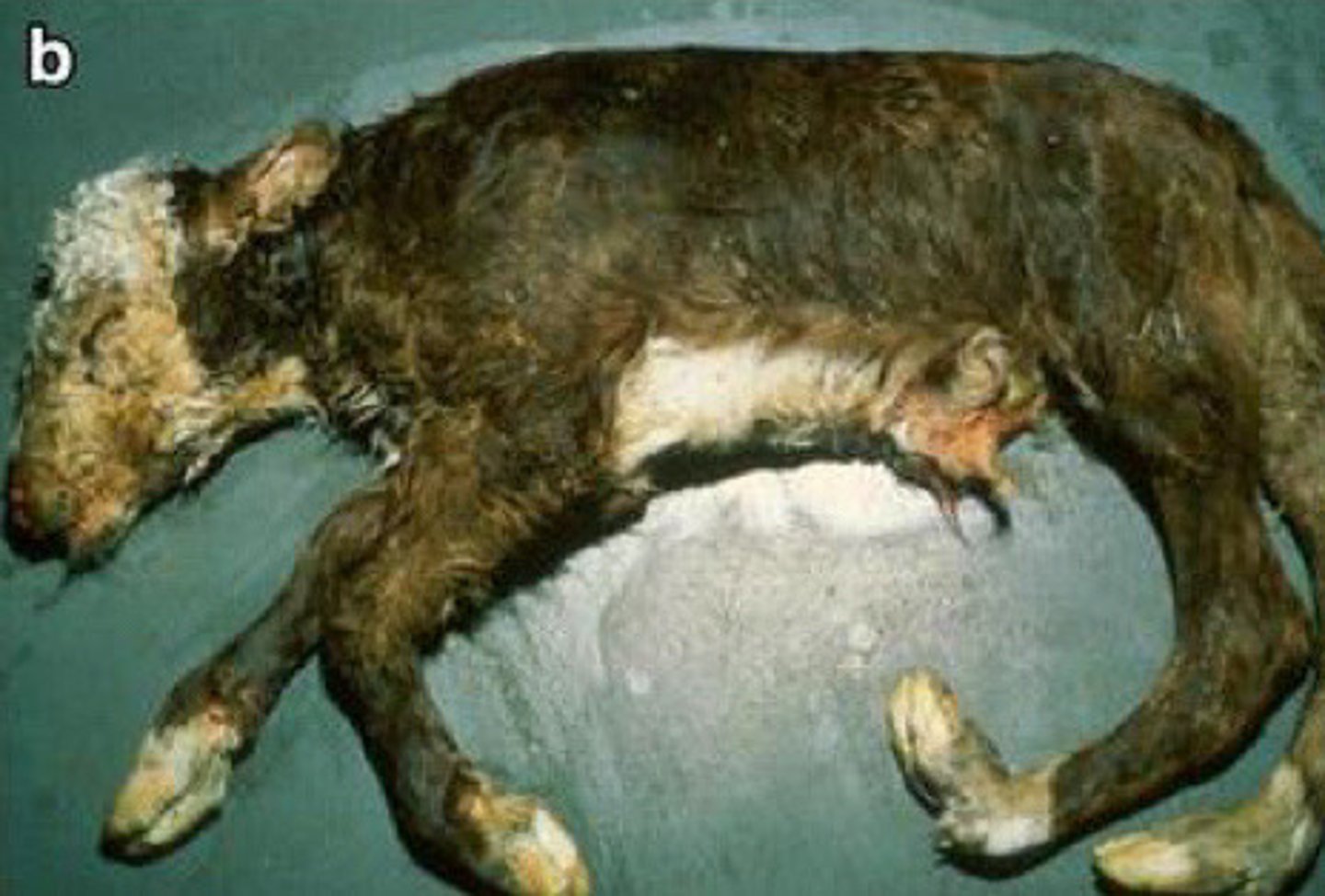6 Bovine Upper Leg Lameness
1/40
There's no tags or description
Looks like no tags are added yet.
Name | Mastery | Learn | Test | Matching | Spaced |
|---|
No study sessions yet.
41 Terms
Beef
Upper leg lameness is more common in beef or dairy cattle
Culling/Euthanasia
What is the most commonly considered treatment for true upper leg lameness in cattle?
Stifle (CCL lesions are common)
What joint is the most common cause of upper leg lameness in cattle?
Lower limb lameness
What similar problem do you need to rule out for cattle before jumping to upper limb lameness?
Arthrogryposis
The term "gryposis" means abnormal bending or curvature
This is congenital limb contracture with a poor prognosis. Manifests Genetically as curly calf syndrome (angus), spinal dysraphism (charolaise), and vertebral manifestation (holstein) OR in utero thru viral infection
Septic arthritis
This is more common in neonates, where affected joints (often hock, stifle, and carpus) are warm, swollen and painful. Synovial fluid will have increased leukocyte count. Prognosis gets worse the more joints are affected --> joint lavage, regional limb perfusion
Contracted tendons
This is a common congenital problem in cattle, usually at the carpus or fetlock. May be able to do physical therapy, manual stretching, or therapy. Caused by in utero malposition
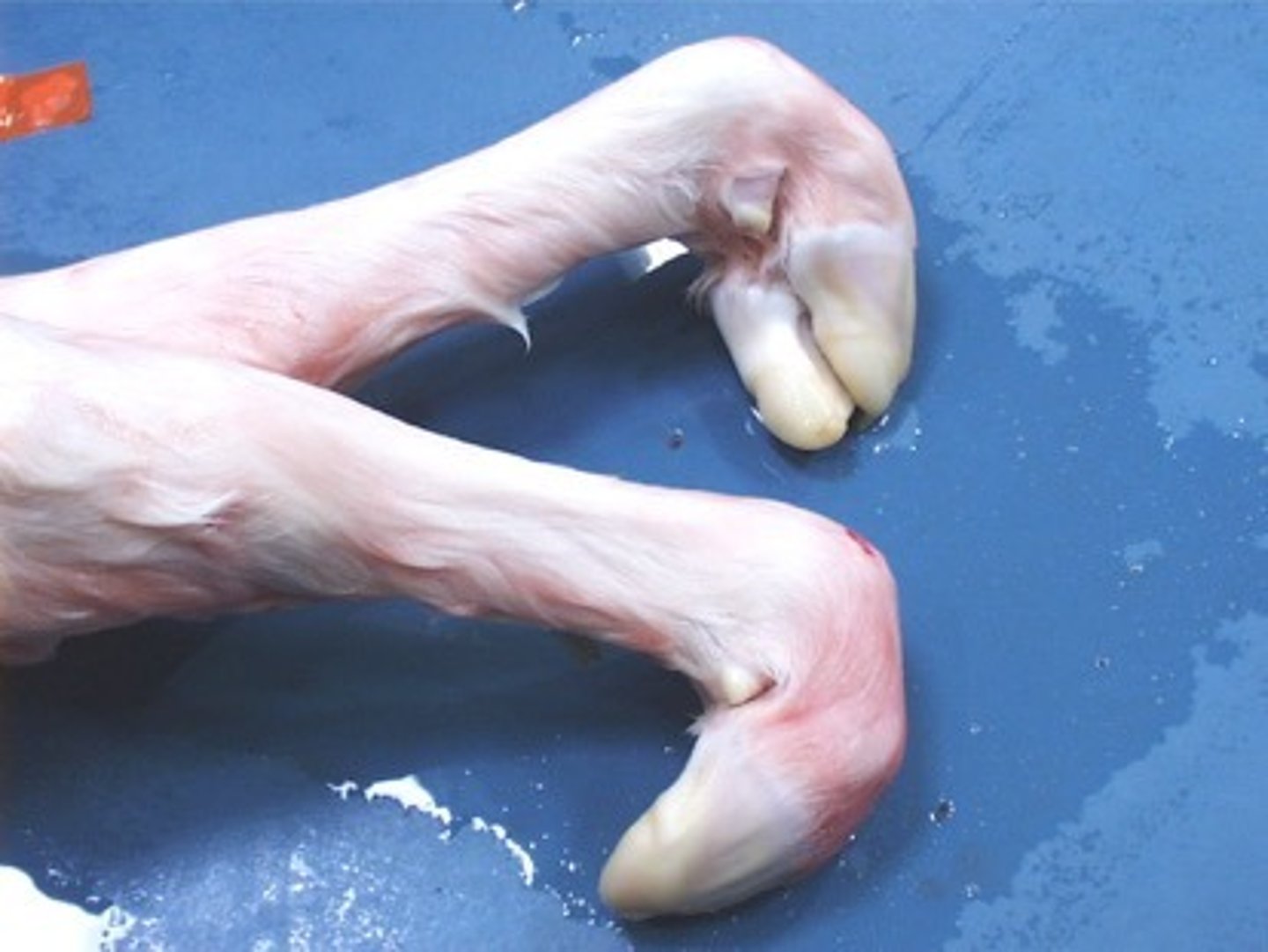
Hygroma
This is localized swelling of tissue, where the capsule is filled with fluid surrounded by a layer of fibrous tissue caused by intermittent trauma (like lack of bedding) --> surgical excision
Osteochondrosis
This problem occurs with blood supply failure leading to focal ischemia and subchondral bone cysts. Metaphyseal growth plate and immature joint cartilage is affected in hock, stifle, and atlanto-occipital joints. Chronic lameness that worsens overtime
Bilateral
It is more common that osteochondrosis is unilateral or bilateral
Upward patellar fixation
This occurs when the patella becomes fixed on the proximal aspect of the medial trochlear ridge of the femur (though more common in horses). Limb is locked in extension intermittently
Upward patellar fixation
What is happening here?
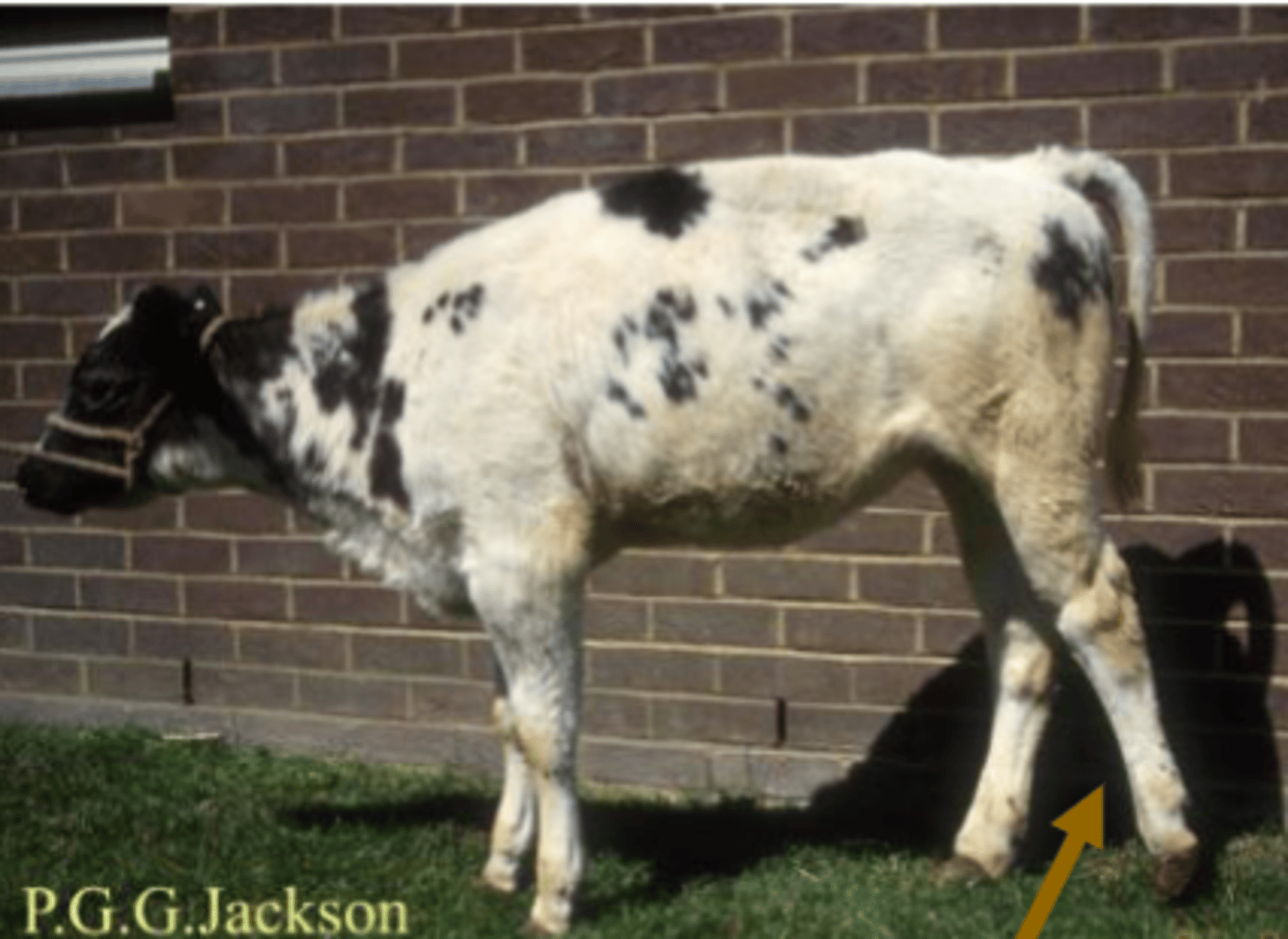
Brahman cattle and working cattle
What types of cattle is upward patellar fixation common in?
3: medial, middle, and lateral
How many patellar ligaments do cattle have? What are they?
Medial patellar desmotomy (ligament cutting) or vastus medialis tenotomy
(in horses-i think it applies to cows-this is the problem where you also back them up to engage the quadriceps mechanism)
How can you treat upward patellar fixation?
Gastrocnemius tear
DIFFERENTIALS: tibial nerve paralysis
This muscle originates from the caudal femoral surface and inserts just dorsal to the point of the hock by 2 strong tendons. What has happened with this muscle if the animal is unable to rise, with the hock touching the ground when they attempt to stand? What are some differentials?
Peronius tertius tear or rupture
This muscle is responsible for hock flexion and tarsal flexion. If a cow is toe touching lame but not painful, has an inability to flex the hock, and the limb can be pulled backward with little effort, what has happened?
Elso Heel or Spastic paresis
This is a progressive condition in cattle with overextension of pelvis limbs (contraction of gastrocnemius). Cow has a stiff pendulous limb and a hard, rigid gastrocnemius muscle. GENETIC CONDITION starts young at 2-10 months of age
Cranial cruciate rupture/tear
This structure limits cranial tibial displacement and prevents internal rotation. So, if a cow has marked lameness, outward rotation of the leg, stifle joint effusion, and clunk sound at walk, what has happened?
Cranial cruciate rupture
What is one of the most common causes of stifle associated lameness in cattle?
Trauma or secondary to DJD
How can cows get cranial cruciate rupture?
Physical exam, rule out distal limb lameness, cranial drawer, clicking sound when walking or standing, x-rays
How can you diagnose cranial cruciate rupture in cattle?
Surgical repair (extracapsular imbrication and ligament replacement) and NSAIDs
What is the only way to treat cranial cruciate rupture in cattle?
Craniodorsal luxation
What is the most common coxofemoral luxation in cows?
Dairy cattle (even more common in cows than horses)
Describe the type of cow coxofemoral luxation is more common in
TRAUMA or PARTURITION (hypocalcemia)
What typically causes coxofemoral luxation in cattle?
Coxofemoral luxation
This problem may be caused by joint instability in the joint capsule, femoral head ligament, or gluteal muscles and deep hip muscles in cattle
Abduct leg while palpating hip for crepitus, see if greater range of motion of proximal femur during abduction (ventral luxation)
Diagnose with severe gluteal swelling, rectal palpation, and x-ray
How can you assess coxofemoral luxation?
Coxofemoral luxation
(greater trochanter is femur)
A cow is suddenly non weight bearing lame this morning. You see there is asymmetry of the greater trochanters, shortening of the limb, and increased laxity of the hip joint upon palpation. What has likely happened?
Closed reduction in first 48 hours + hobbles (recurrence rate is high), open reduction or femoral head ostectomy
How can you treat coxofemoral luxation in cattle?
Spinal fracture, spinal tumor, spinal abscess, lymphoma
Prognosis is poor (esp. for spinal fracture)
A cow is down, dog sitting, and does not have any rear leg sensation upon your physical exam. What are some differential diagnosis?
Chondrodysplasia
This heritable disorder in cattle is most notable in recessive homozygous "bulldog calves"
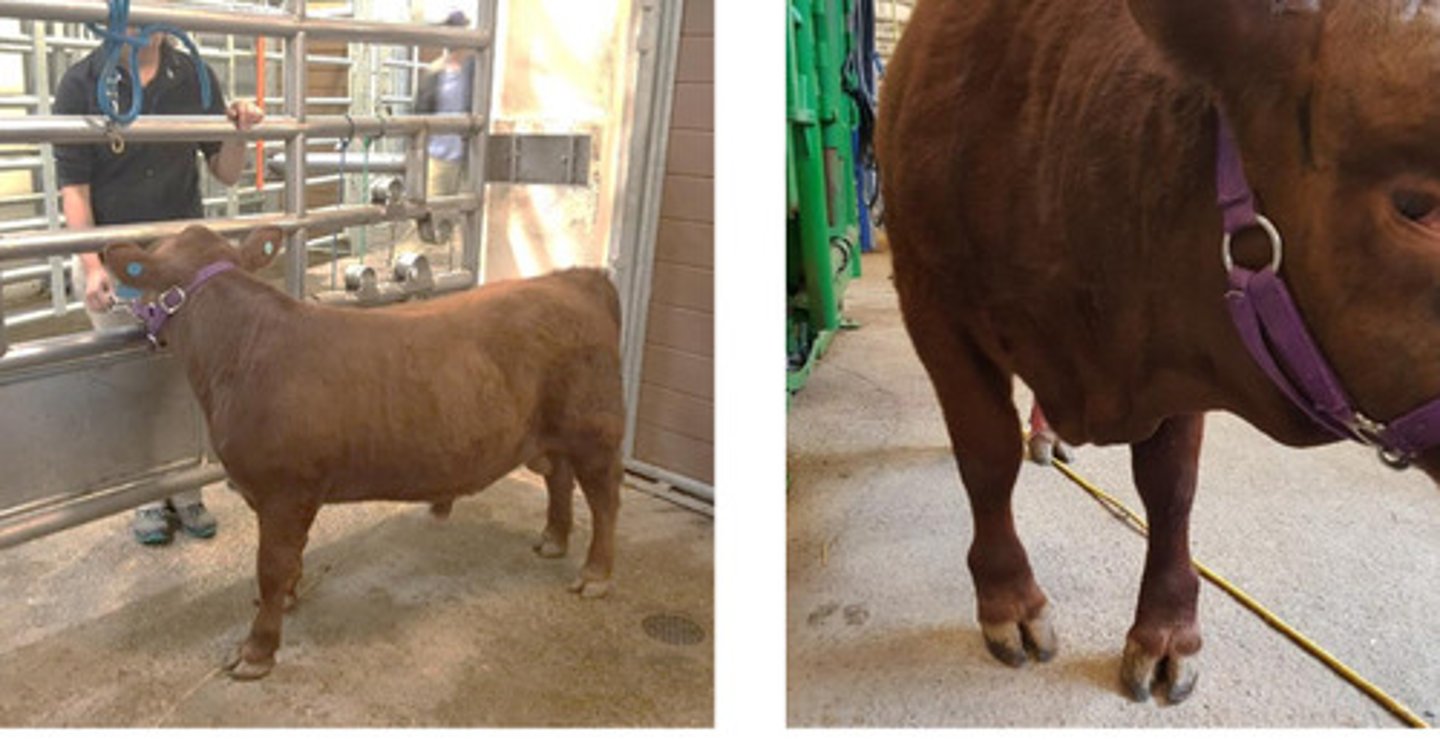
Cranial Cruciate rupture/tear
What is this?
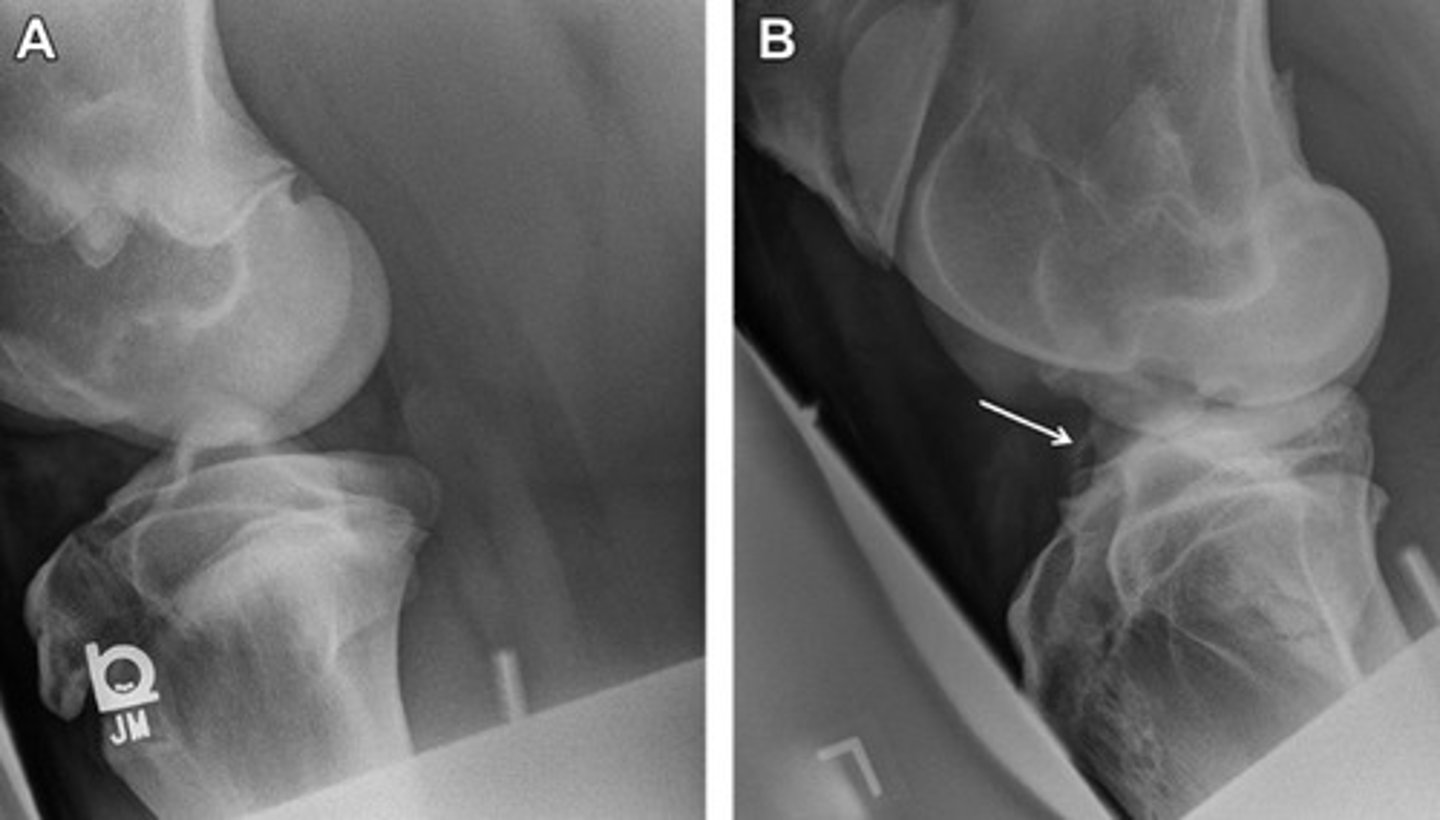
Elso heel (spastic paresis)
What is this?
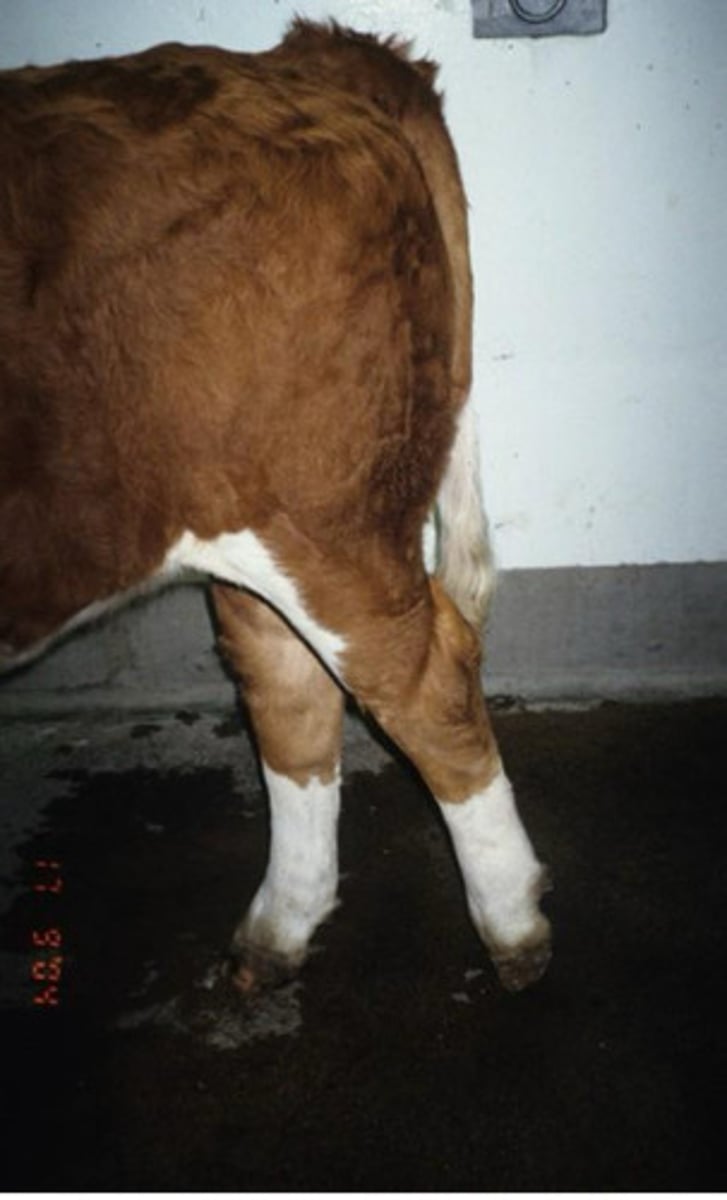
Peronius Tertius tear/rupture
What is this?
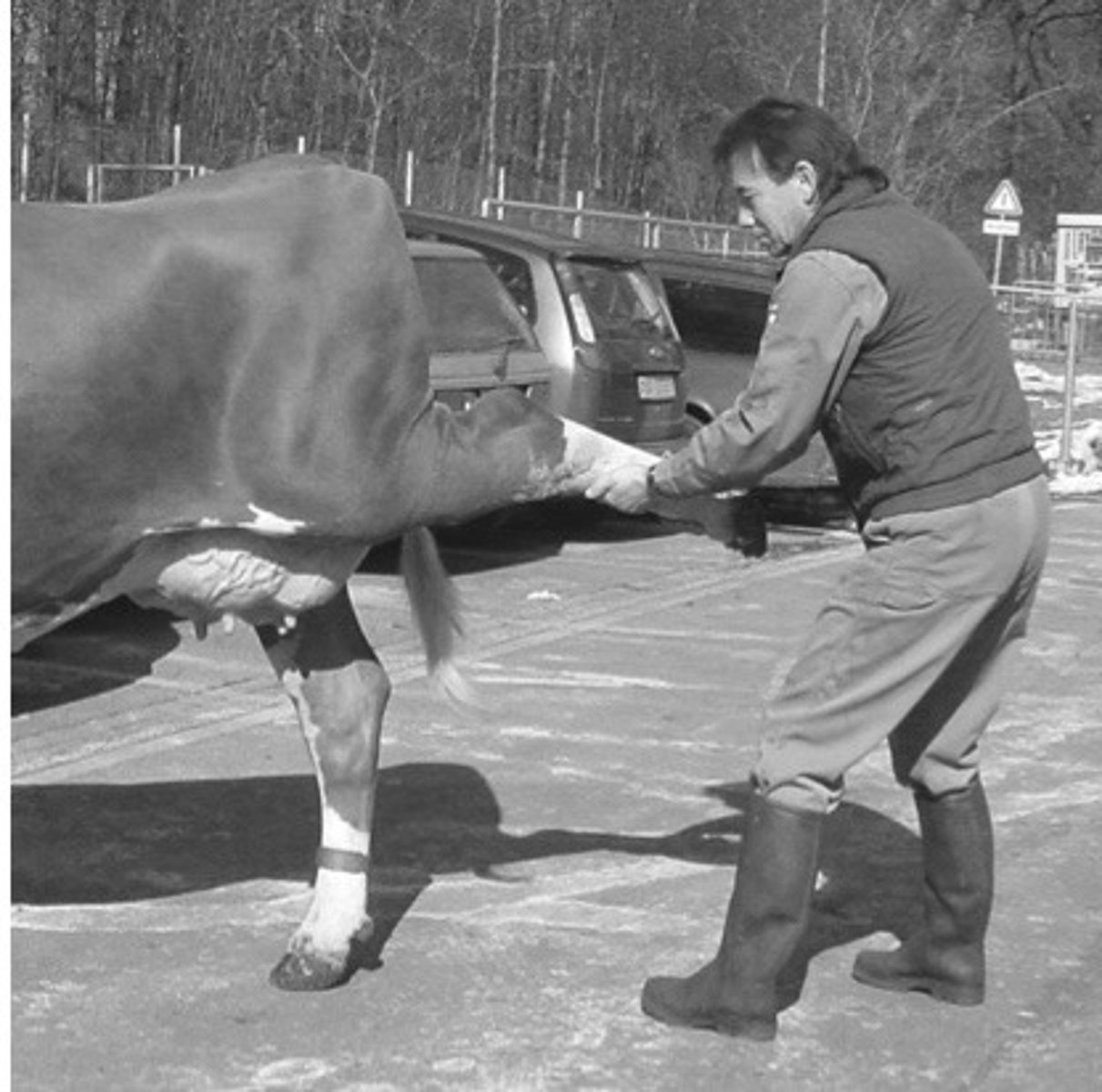
Gastrocnemius tear
What is this?
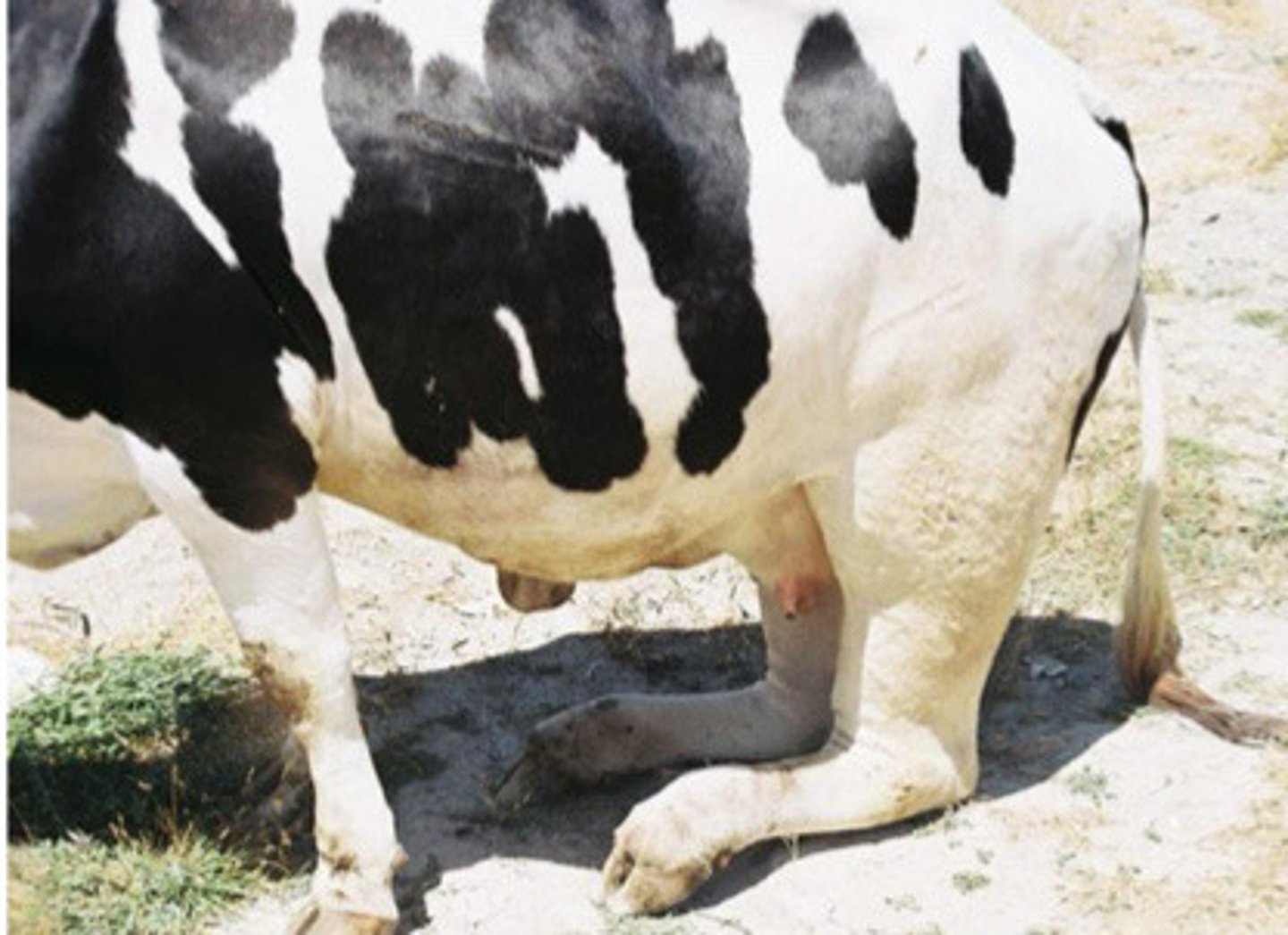
osteochondrosis
What is this?

hygroma
What is this?
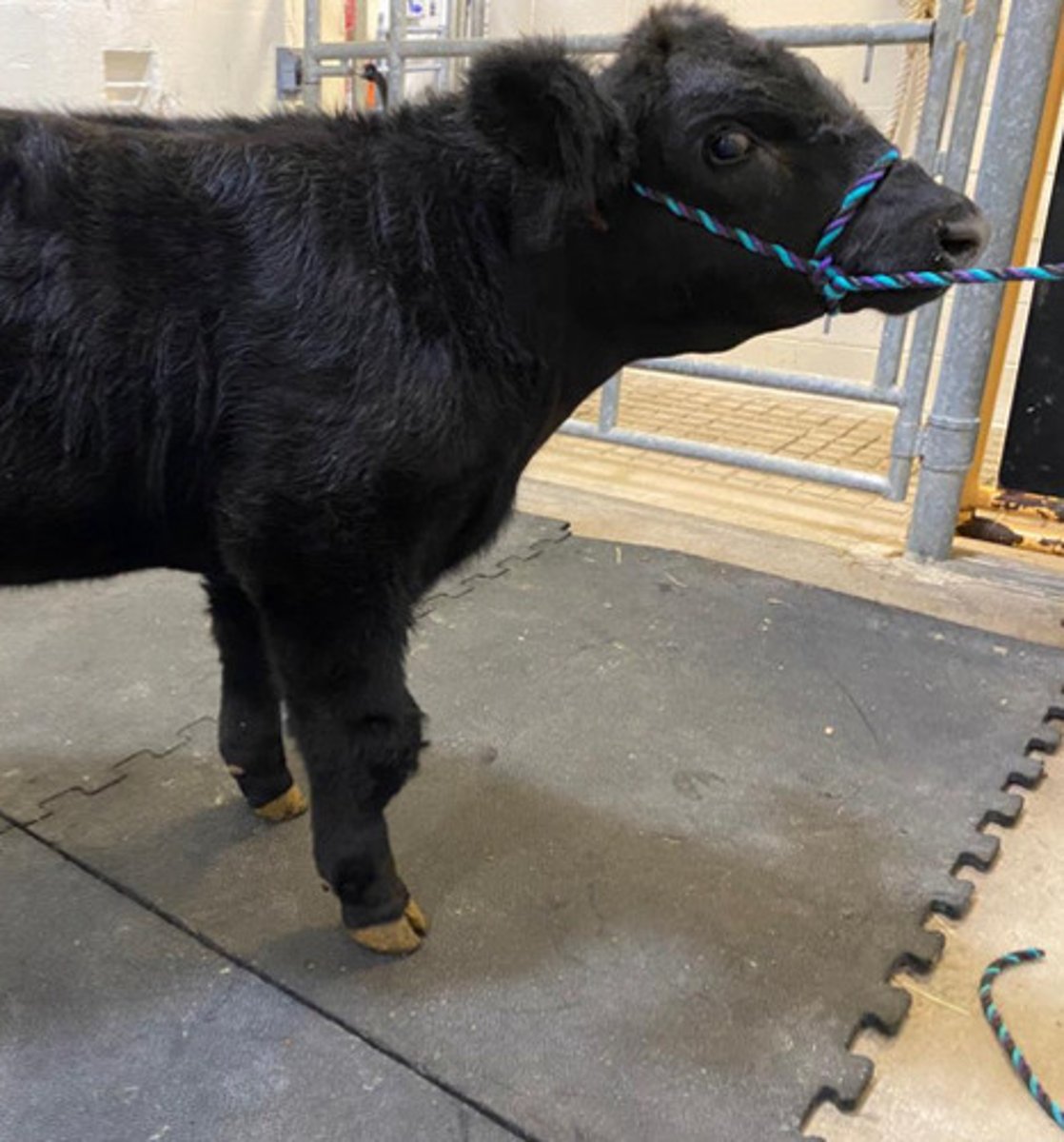
Septic Arthritis
What is this?
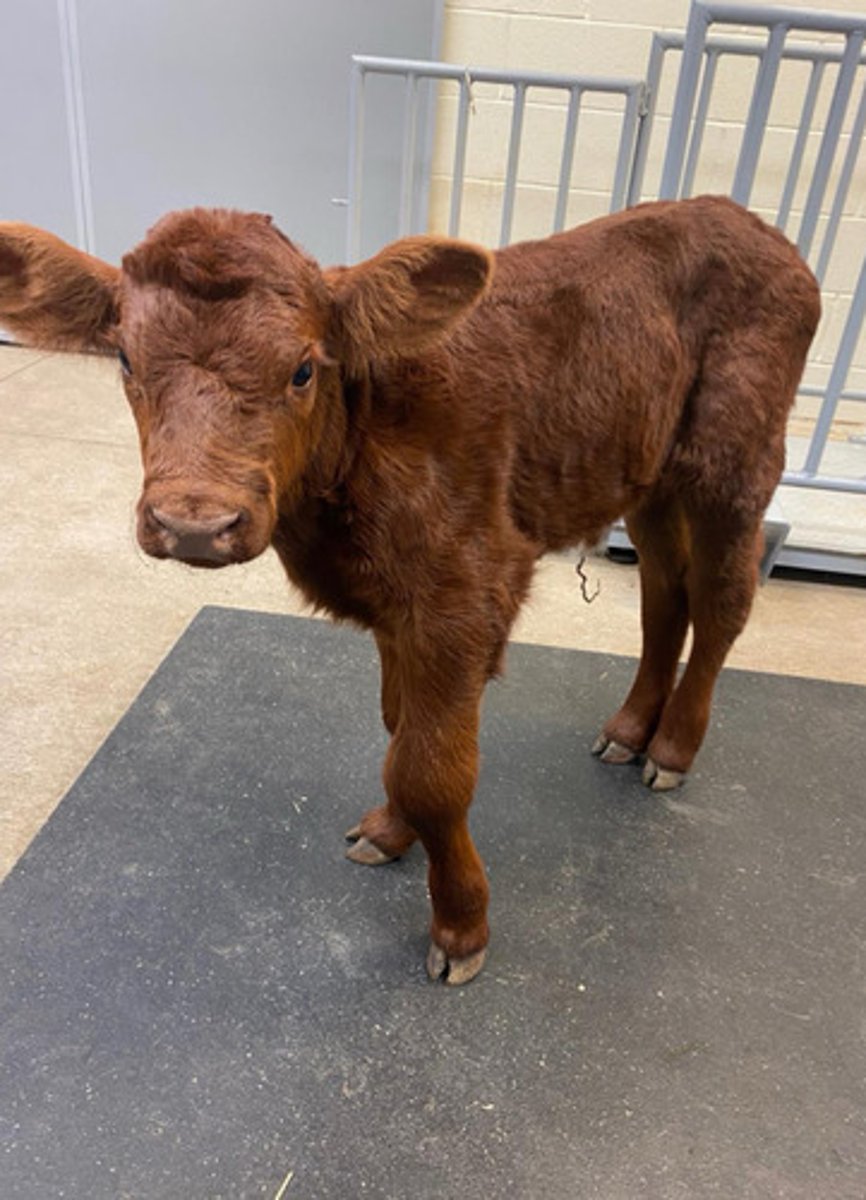
Arthrogryposis
What is this?

arthrogryposis
What is this?
